| Listing 1 - 10 of 510 | << page >> |
Sort by
|
Book
ISBN: 9780521896030 0521896037 9780511781865 9780511776267 0511776268 9780511773686 0511773684 0511781865 9786612657924 6612657928 110721209X 1282657925 0511775504 0511772610 0511774745 9781282657922 9780511775505 9780511772610 9780511774744 Year: 2010 Publisher: Cambridge Cambridge University Press
Abstract | Keywords | Export | Availability | Bookmark
 Loading...
Loading...Choose an application
- Reference Manager
- EndNote
- RefWorks (Direct export to RefWorks)
Group theory has long been an important computational tool for physicists, but, with the advent of the Standard Model, it has become a powerful conceptual tool as well. This book introduces physicists to many of the fascinating mathematical aspects of group theory, and mathematicians to its physics applications. Designed for advanced undergraduate and graduate students, this book gives a comprehensive overview of the main aspects of both finite and continuous group theory, with an emphasis on applications to fundamental physics. Finite groups are extensively discussed, highlighting their irreducible representations and invariants. Lie algebras, and to a lesser extent Kac-Moody algebras, are treated in detail, including Dynkin diagrams. Special emphasis is given to their representations and embeddings. The group theory underlying the Standard Model is discussed, along with its importance in model building. Applications of group theory to the classification of elementary particles are treated in detail.
Group theory --- Group theory. --- Groups, Theory of --- Substitutions (Mathematics) --- Algebra
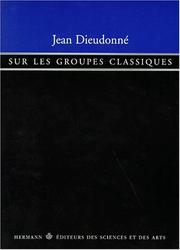
ISBN: 2705610405 9782705610401 Year: 1973 Volume: 1040 6 Publisher: Paris Hermann
Abstract | Keywords | Export | Availability | Bookmark
 Loading...
Loading...Choose an application
- Reference Manager
- EndNote
- RefWorks (Direct export to RefWorks)
Group theory. --- Group theory --- Groups, Theory of --- Substitutions (Mathematics) --- Algebra
Book
ISBN: 113923725X 1108050328 Year: 2012 Publisher: Cambridge : Cambridge University Press,
Abstract | Keywords | Export | Availability | Bookmark
 Loading...
Loading...Choose an application
- Reference Manager
- EndNote
- RefWorks (Direct export to RefWorks)
The British mathematician William Burnside (1852-1927) and Ferdinand Georg Frobenius (1849-1917), Professor at Zurich and Berlin universities, are considered to be the founders of the modern theory of finite groups. Not only did Burnside prove many important theorems, but he also laid down lines of research for the next hundred years: two Fields Medals have been awarded for work on problems suggested by him. The Theory of Groups of Finite Order, originally published in 1897, was the first major textbook on the subject. The 1911 second edition (reissued here) contains an account of Frobenius's character theory, and remained the standard reference for many years.
Group theory. --- Groups, Theory of --- Substitutions (Mathematics) --- Algebra
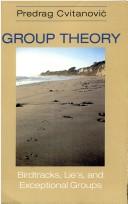
ISBN: 1282964801 9786612964800 1400837677 9781400837670 9780691118369 0691118361 Year: 2008 Publisher: Princeton, N.J. Princeton University Press
Abstract | Keywords | Export | Availability | Bookmark
 Loading...
Loading...Choose an application
- Reference Manager
- EndNote
- RefWorks (Direct export to RefWorks)
If classical Lie groups preserve bilinear vector norms, what Lie groups preserve trilinear, quadrilinear, and higher order invariants? Answering this question from a fresh and original perspective, Predrag Cvitanovic takes the reader on the amazing, four-thousand-diagram journey through the theory of Lie groups. This book is the first to systematically develop, explain, and apply diagrammatic projection operators to construct all semi-simple Lie algebras, both classical and exceptional. The invariant tensors are presented in a somewhat unconventional, but in recent years widely used, "birdtracks" notation inspired by the Feynman diagrams of quantum field theory. Notably, invariant tensor diagrams replace algebraic reasoning in carrying out all group-theoretic computations. The diagrammatic approach is particularly effective in evaluating complicated coefficients and group weights, and revealing symmetries hidden by conventional algebraic or index notations. The book covers most topics needed in applications from this new perspective: permutations, Young projection operators, spinorial representations, Casimir operators, and Dynkin indices. Beyond this well-traveled territory, more exotic vistas open up, such as "negative dimensional" relations between various groups and their representations. The most intriguing result of classifying primitive invariants is the emergence of all exceptional Lie groups in a single family, and the attendant pattern of exceptional and classical Lie groups, the so-called Magic Triangle. Written in a lively and personable style, the book is aimed at researchers and graduate students in theoretical physics and mathematics.
Group theory. --- Groups, Theory of --- Substitutions (Mathematics) --- Algebra
Book
ISBN: 1614441022 9781614441021 9780883857571 088385757X Year: 2009 Publisher: Washington, DC : Mathematical Association of America,
Abstract | Keywords | Export | Availability | Bookmark
 Loading...
Loading...Choose an application
- Reference Manager
- EndNote
- RefWorks (Direct export to RefWorks)
Group theory. --- Groups, Theory of --- Substitutions (Mathematics) --- Algebra
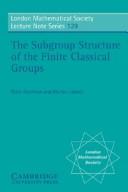
ISBN: 1139884417 1107366410 1107371139 1107361508 1107369746 1299404200 1107363950 051189239X 0511629230 9781107361508 9780511892394 9781107366411 9780511629235 9781107371132 9781107369740 9781299404205 9781107363953 052135949X 9780521359498 Year: 1990 Publisher: Cambridge Cambridge University Press
Abstract | Keywords | Export | Availability | Bookmark
 Loading...
Loading...Choose an application
- Reference Manager
- EndNote
- RefWorks (Direct export to RefWorks)
With the classification of the finite simple groups complete, much work has gone into the study of maximal subgroups of almost simple groups. In this volume the authors investigate the maximal subgroups of the finite classical groups and present research into these groups as well as proving many new results. In particular, the authors develop a unified treatment of the theory of the 'geometric subgroups' of the classical groups, introduced by Aschbacher, and they answer the questions of maximality and conjugacy and obtain the precise shapes of these groups. Both authors are experts in the field and the book will be of considerable value not only to group theorists, but also to combinatorialists and geometers interested in these techniques and results. Graduate students will find it a very readable introduction to the topic and it will bring them to the very forefront of research in group theory.
Group theory. --- Groups, Theory of --- Substitutions (Mathematics) --- Algebra --- Group theory
Book
ISBN: 1613249683 9781613249680 9781608761753 1608761754 Year: 2010 Publisher: New York
Abstract | Keywords | Export | Availability | Bookmark
 Loading...
Loading...Choose an application
- Reference Manager
- EndNote
- RefWorks (Direct export to RefWorks)
Group theory. --- Groups, Theory of --- Substitutions (Mathematics) --- Algebra
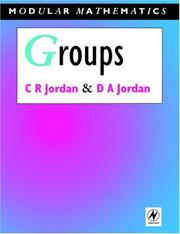
ISBN: 1283587394 9786613899842 0080571654 9780080571652 034061045X 9780340610459 9781283587396 6613899844 Year: 1994 Publisher: Oxford Newnes
Abstract | Keywords | Export | Availability | Bookmark
 Loading...
Loading...Choose an application
- Reference Manager
- EndNote
- RefWorks (Direct export to RefWorks)
This text provides an introduction to group theory with an emphasis on clear examples. The authors present groups as naturally occurring structures arising from symmetry in geometrical figures and other mathematical objects. Written in a 'user-friendly' style, where new ideas are always motivated before being fully introduced, the text will help readers to gain confidence and skill in handling group theory notation before progressing on to applying it in complex situations. An ideal companion to any first or second year course on the topic.
Group theory. --- Groups, Theory of --- Substitutions (Mathematics) --- Algebra
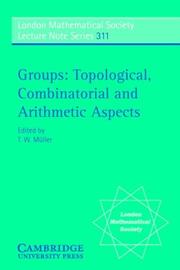
ISBN: 9780511550706 9780521542876 9781107362314 1107362318 0511550707 129940488X 9781299404885 9781107367227 1107367220 9781107368231 1107368235 0521542871 1139882155 1107371821 1107364760 Year: 2004 Publisher: Cambridge New York Cambridge University Press
Abstract | Keywords | Export | Availability | Bookmark
 Loading...
Loading...Choose an application
- Reference Manager
- EndNote
- RefWorks (Direct export to RefWorks)
In 1999 a number of eminent mathematicians were invited to Bielefeld to present lectures at a conference on topological, combinatorial and arithmetic aspects of (infinite) groups. The present volume consists of survey and research articles invited from participants in this conference. Topics covered include topological finiteness properties of groups, Kac-Moody groups, the theory of Euler characteristics, the connection between groups, formal languages and automata, the Magnus-Nielsen method for one-relator groups, atomic and just infinite groups, topology in permutation groups, probabilistic group theory, the theory of subgroup growth, hyperbolic lattices in dimension three, generalised triangle groups and reduction theory. All contributions are written in a relaxed and attractive style, accessible not only to specialists, but also to good graduate and post-graduate students, who will find inspiration for a number of basic research projects at various levels of technical difficulty.
Group theory. --- Groups, Theory of --- Substitutions (Mathematics) --- Algebra
Book
ISBN: 0828402884 9780828402880 Year: 1976 Publisher: New York (N.Y.): Chelsea
Abstract | Keywords | Export | Availability | Bookmark
 Loading...
Loading...Choose an application
- Reference Manager
- EndNote
- RefWorks (Direct export to RefWorks)
Group theory --- GROUPS, theory of --- 512 --- Groups, Theory of --- Substitutions (Mathematics) --- Algebra --- 512 Algebra
| Listing 1 - 10 of 510 | << page >> |
Sort by
|

 Search
Search Feedback
Feedback About UniCat
About UniCat  Help
Help News
News